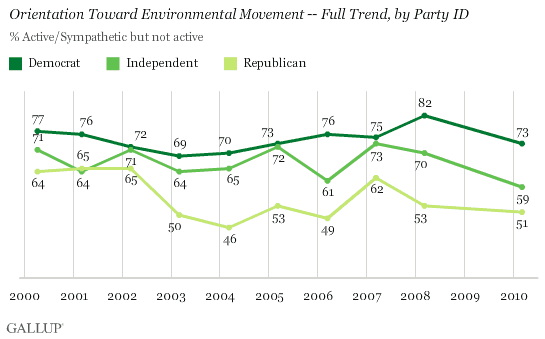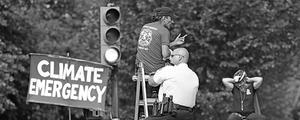April 22 marks the 40th anniversary of the first Earth Day, an event widely considered to be the birth of the modern environmental movement. Few social movements survive 40 years, so in this sense alone, environmentalism might be considered successful. On the other hand, the movement has had limited success in policy arenas in recent years, leading to allegations of the "death of environmentalism."[1] In addition, this year's Gallup Environment poll finds historically low levels of public worry about environmental problems (particularly global warming) and support for environmental protection. Are we witnessing the end of environmentalism as a significant social movement and, in the eyes of many, a major progressive force in the United States?
Orientation Toward the Environmental Movement
In 2000, Gallup began asking about perceptions of and involvement in the environmental movement. Although conducted a decade after public support for environmental protection peaked in the early 1990s (in conjunction with the widely celebrated 20th anniversary of Earth Day),[2] the 2000 poll found large majorities of Americans holding positive views toward the movement.[3] However, there has been a downturn in these views over the last 10 years, and they have hit new lows in this year's poll.
When Americans are asked to indicate their stance vis-à-vis the environmental movement -- on a spectrum from active participant to unsympathetic -- this year, 19% report being an "active participant," 42% being "sympathetic towards the movement, but not active," 28% being "neutral" and 10% being "unsympathetic."
Since 2000, there has been a slight increase in the percentage of Americans claiming to be active participants in the movement, from 16% to 19%, but a noticeable decline of 13 percentage points in those claiming to be sympathetic to the movement. The result is a 10-point drop (from 71% to 61%) in the overall percentage of Americans holding a positive orientation toward the environmental movement over the past decade. This decline is mirrored in the 10-point overall increase in those claiming to be neutral or unsympathetic toward the movement (from 28% to 38%). These results suggest that while it still enjoys majority support, the environmental movement is less consensual than it was a decade ago, with about 6 in 10 Americans now being active in or sympathetic toward it.
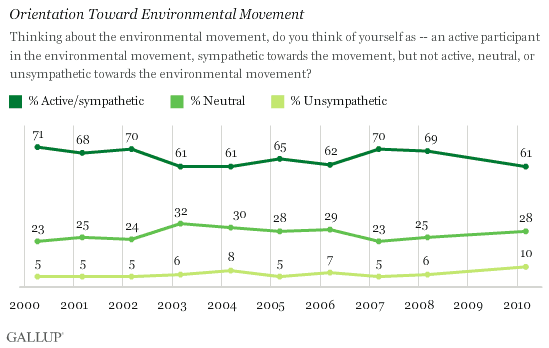
A second item asks respondents whether they think the environmental movement has done more good than harm, or vice versa, and a similar but slightly stronger pattern emerges. This year, 22% respond that the movement has "definitely done more good than harm" and 40% that it has "probably done more good than harm," for a total of 62% holding a positive view. This reflects a decline of 13 points since 2000. Conversely, there has been a 15-point rise since 2000 in the overall percentage saying the environmental movement has done more harm than good.
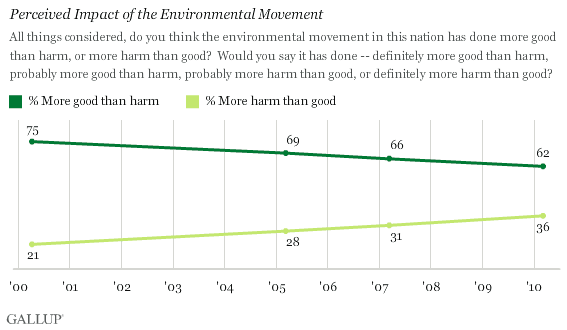
No doubt many factors, particularly the state of the economy, have contributed to the overall lower levels of public concern about environmental problems as well as the less positive views of the environmental movement in this year's survey. The growing political polarization over environmental issues is likely another key factor.[4] This has been most apparent in the case of global warming,[5] but political polarization is not confined to this issue. In fact, it shows up in evaluations of the environmental movement.
Among self-identified Democrats there was a moderate increase (from 14% to 24%) between 2000 and 2010 in the percentage claiming active membership in the environmental movement, but a 13-point decline (from 63% to 50%) in the percentage saying they were sympathetic to the movement. The result is a slight three-point decline in positive orientation toward the movement among Democrats over the past decade.
In contrast, while the percentage of Republicans claiming active membership remained stable (going from 14% to 15%), the percentage holding a sympathetic view of the movement dropped 14 percentage points, from 50% in 2000 to 36% this year. The overall result is a 13-point decline in positive orientation toward the movement among Republicans over the decade. Particularly notable is the doubling of Republicans who say they are unsympathetic to the movement, from 8% to 18%.
Independents also show a noticeable decline in positive orientation toward environmentalism, from 70% in 2000 to 59% this year, all due to a drop in the sympathetic category. The result is that their current orientation toward the movement is closer to Republicans' orientation than to Democrats'.
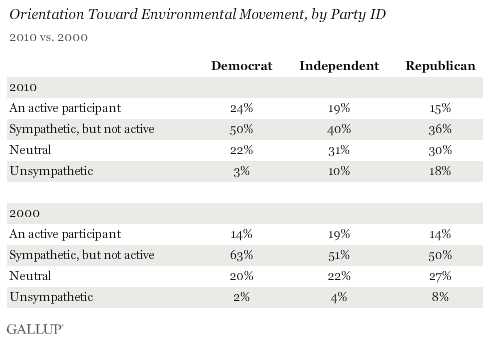
The trend in partisan perceptions of the impact of the environmental movement reveals a similar pattern. There has been a modest (5-point) decline since 2000 in the percentage of Democrats who believe the environmental movement has definitely or probably done more good than harm (from 80% to 75%), but among Republicans the decline is 21 points (from 70% to 49%). The 10-point difference between partisans' positive evaluations of the movement in 2000 more than doubled to 26 points this year. The 13-point decline among independents, from 75% to 62%, puts them about midway between the partisans, as they were in 2000, when the differences between Republicans and Democrats were substantially smaller.

These results indicate that the decline in positive views of the environmental movement among Americans over the past decade is disproportionately the result of substantial declines among Republicans, which dwarf those among Democrats. A similar pattern, not shown here, occurs for political ideology, with support for the environmental movement declining more noticeably among conservatives than liberals over the last 10 years.
This process of political polarization over environmental issues and the movement more broadly seems unlikely to abate in the near future, given current political conflict over issues such as climate change -- especially policy proposals for reducing carbon emissions.
Personal Environmental Behaviors and Activism
Interestingly, even as this year's Environment poll reveals a noticeable rise in negative views of the environmental movement, it also documents considerable stability in personal environmental behaviors and activism.
Respondents' self-reported engagement in eight types of "pro-environmental" behavior show a striking degree of stability over the past decade. The percentages of Americans who report engaging in the most popular and easiest-to-perform behaviors either stayed the same (recycling) or experienced negligible increases (reducing household energy and making "green" purchases).
For the five items tapping various forms of activism, small declines occurred for contributing money to a group (hardly surprising, given current economic conditions) and contacting a business to complain about harmful products (the least common of all the behaviors). Being active in an environmental group or organization, voting for candidates because of their environmental positions, and contacting public officials about an environmental issue remained virtually unchanged from 2000 to 2010.
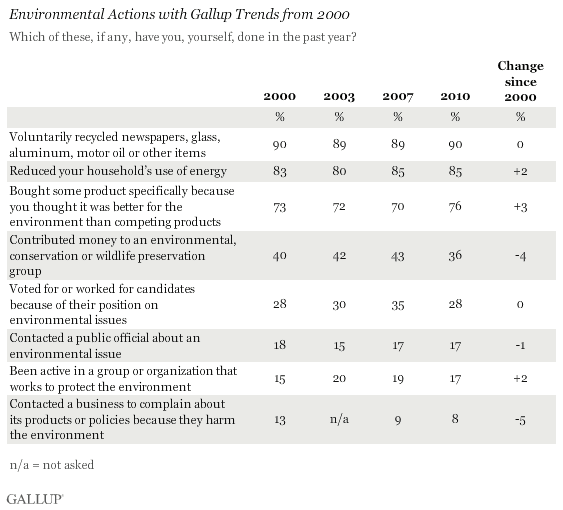
Implications
In sum, even as the American public has developed a somewhat less positive view of the environmental movement over the past decade, it continues to embrace many pro-environmental behaviors. This suggests that some of the goals of environmentalism, such as promoting recycling, have become widely accepted (even if the degree of recycling remains much lower than its potential) and noncontroversial among Americans. Further, the (often large) minorities of Americans who engage in various forms of environmental activism -- such as being active in an environmental group or taking the issue into account when they vote -- remain stable, despite the declining popularity of the environmental movement among the public at large.
The overall message seems to be that even though the environmental movement is the subject of more conflict than ever, individual behaviors in support of it endure. While environmentalism thus seems far from dead, activists are surely hoping that 2010 marks a temporary low point in public support for its goals. Without such support, the movement will continue to decline in effectiveness.
Riley E. Dunlap is Gallup Scholar for the Environment and Regents Professor of Sociology at Oklahoma State University.
Results are based on telephone interviews with 1,014 national adults, aged 18 and older, conducted March 4-7, 2010. For results based on the total sample of national adults, one can say with 95% confidence that the maximum margin of sampling error is ±4 percentage points.
For results based on the 519 national adults in the Form A half-sample and 495 national adults in the Form B half-sample, the maximum margins of sampling error are ±5 percentage points.
Interviews are conducted with respondents on landline telephones (for respondents with a landline telephone) and cellular phones (for respondents who are cell phone only).
In addition to sampling error, question wording and practical difficulties in conducting surveys can introduce error or bias into the findings of public opinion polls.
[1]Ted Nordhaus and Michael Shellenberger, Break Through: From the Death of Environmentalism to the Politics of Possibility. New York: Houghton-Mifflin, 2007.
[2] Riley E. Dunlap, "An Enduring Concern: Light Stays Green for Environmental Protection," Public Perspective 13 (September/October, 2002), pp. 10-14.
[3] Riley E. Dunlap, "Americans Have Positive Image of the Environmental Movement," Gallup Poll Monthly, No. 415 (April, 2000), pp. 19-25.
[4] In 1970 environmental protection was widely touted as a consensual, apolitical issue. While most surveys did find a moderate but statistically significant tendency for political liberals to express more "pro-environment" views than did their conservative counterparts, the results for party identification were typically weaker. Democrats were generally found to hold somewhat more pro-environmental views than did Republicans, but the differences were often not statistically significant. The pattern began to change in the mid-1990s, as partisan differences became more noticeable -- particularly among political elites such as members of Congress but also among the general public (with Republicans expressing significantly less pro-environmental views than their Democratic counterparts in national surveys). For a review of relevant studies and trend data through the late 1990s see Riley E. Dunlap, Chenyang Xiao and Aaron M. McCright, "Politics and Environment in America: Partisan and Ideological Cleavages in Public Support for Environmentalism," Environmental Politics, Vol. 10 (Winter, 2000), pp. 23-48.
[5] For evidence of growing ideological polarization in views of global warming see Jeffrey M. Jones, "Conservatives' Doubts About Global Warming Grow," March 11, 2010 at https://www.gallup.com/poll/126563/Conservatives-Doubts-Global-Warming-Grow.aspx and for evidence of growing partisan polarization see Riley E. Dunlap, "Climate-Change Views: Republic-Democratic Gaps Expand," May 29, 2008 at https://www.gallup.com/poll/107569/ClimateChange-Views-RepublicanDemocratic-Gaps-Expand.aspx. Also see Riley E. Dunlap and Aaron M. McCright, "A Widening Gap: Republican and Democratic Views on Climate Change," Environment 50 (September/October, 2008), pp. 26-35.
